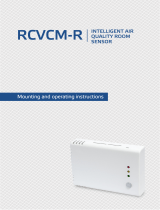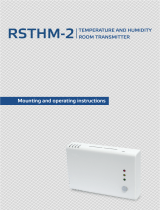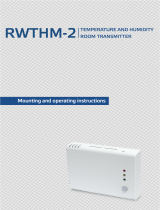Sentera Controls RSVCG-R Mounting Instruction
- Type
- Mounting Instruction

RSVCX-R AIR QUALITY ROOM
TRANSMITTER
Mounting and operating instructions

www.sentera.eu
MIW-RSVCX-R-EN-000 - 24 / 02 / 2021 2 - 10
back to the table of contents
RSVCX-R AIR QUALITY ROOM
TRANSMITTER
Table of contents
SAFETY AND PRECAUTIONS 3
PRODUCT DESCRIPTION 4
ARTICLE CODE 4
INTENDED AREA OF USE 4
TECHNICAL DATA 4
STANDARDS 4
OPERATIONAL DIAGRAMS 5
WIRING AND CONNECTIONS 5
MOUNTING & OPERATING INSTRUCTIONS IN STEPS 6
OPERATING INSTRUCTIONS 8
Verification of installation instructions 9
TRANSPORT AND STORAGE 9
WARRANTY AND RESTRICTIONS 9
MAINTENANCE 9

www.sentera.eu
MIW-RSVCX-R-EN-000 - 24 / 02 / 2021 3 - 10
back to the table of contents
RSVCX-R AIR QUALITY ROOM
TRANSMITTER
SAFETY AND PRECAUTIONS
Read all the information, the datasheet, Modbus map, mounting and operating
instructions and study the wiring and connection diagram before working with the
product. For personal and equipment safety, and for optimum product performance,
make sure you entirely understand the contents before installing, using, or maintaining
this product.
For safety and licensing (CE) reasons, unauthorised conversion and/ or modifications
of the product are inadmissible.
e product should not be exposed to abnormal conditions, such as extreme
temperatures, direct sunlight or vibrations. Long-term exposure to chemical
vapours in high concentration can affect the product performance. Make sure the
work environment is as dry as possible; avoid condensation.
All installations shall comply with local health and safety regulations and local
electrical standards and approved codes. is product can only be installed by
an engineer or a technician who has expert knowledge of the product and safety
precautions.
Avoid contacts with energised electrical parts. Always disconnect the power
supply before connecting, servicing or repairing the product.
Always verify that you apply appropriate power supply to the product and use
appropriate wire size and characteristics. Make sure that all the screws and nuts
are well tightened and fuses (if any) are fitted well.
Recycling of equipment and packaging should be taken into consideration and these
should be disposed of in accordance with local and national legislation/regulations.
In case there are any questions that are not answered, please contact your
technical support or consult a professional.

www.sentera.eu
MIW-RSVCX-R-EN-000 - 24 / 02 / 2021 4 - 10
back to the table of contents
RSVCX-R AIR QUALITY ROOM
TRANSMITTER
PRODUCT DESCRIPTION
RSVCX-R are multifunctional room transmitters which measure temperature,
relative humidity and a broad range of total volatile organic compounds (ТVOCs).
e TVOC concentration is an accurate indicator for indoor air quality and occupancy
of a room. Based on the temperature and relative humidity measurements,
the dew-point temperature is calculated. RSVCX-R feature 3 analogue /
modulating outputs - one for temperature, one for relative humidity and one for
TVOC. All the parameters and measurements are accessible via Modbus RTU.
ARTICLE CODE
Article code Supply Imax
RSVCG-R 18—34 VDC
15—24 VAC ±10%
110 m A
115 m A
RSVCF-R 18—34 VDC 110 m A
INTENDED AREA OF USE
■Measurement of indoor temperature, relative humidity and TVOC
■Monitoring of indoor air quality
■Suitable for residential and commercial buildings
■For indoor use only
TECHNICAL DATA
■3 analogue / modulating outputs:
►0—10 VDCmode: min. load 50 kΩ (RL ≥ 50 kΩ)
►0—20 mA: max. load 500 Ω (RL ≤ 500 Ω)
► PWM (open-collector type): PWM Frequency: 1 kHz, min. load 50 kΩ (RL ≥ 50 kΩ);
PWM voltage level 3,3 VDC or 12 VDC
■Selectable temperature range: 0—50 °C
■Selectable relative humidity range: 0—100 % rH
■Selectable ТVOC range: 1—60.000 ppb
■Warm-up time: 15 minutes
■Ambient light sensor with adjustable ‘active’ and ‘standby’ level
■Replaceable TVOC sensor module
■3 LEDs with adjustable light intensity for status indication
■ Accuracy: ±0,4 °C (0—50 °C); ±3 % rH (0—100 % rH); ±15% of measured TVOC
(1—60.000 ppb TVOC), depending on the selected parameter
■Enclosure:
►rear plate: plastic ABS, black (RAL 9004)
►front cover: ASA, ivory (RAL 9010)
■Protection standard: IP30 (according to EN 60529)
■Operating ambient conditions:
►temperature: 0—50 °C
►rel. humidity: 0—100 % rH (non-condensing)
■Storage temperature: -10—60 °C
STANDARDS
■EMC directive 2014/30/EU:
► EN 60730-1:2011 Automatic electrical controls for household and similar use -
Part 1: General requirements
►standards — Immunity for residential, commercial and light industrial
environments

www.sentera.eu
MIW-RSVCX-R-EN-000 - 24 / 02 / 2021 5 - 10
back to the table of contents
RSVCX-R AIR QUALITY ROOM
TRANSMITTER
► EN 61000-6-1:2007 Electromagnetic compatibility (EMC) - Part 6-1: Generic
standards — Immunity for residential, commercial and light industrial
environments
► EN 61000-6-3:2007 Electromagnetic compatibility (EMC) - Part 6-3: Generic
standards —Emission standard for residential, commercial and light-industrial
environments Amendments A1:2011 and AC:2012 to EN 61000-6-3
► EN 61326-1:2013 Electrical equipment for measurement, control and laboratory
use - EMC requirements - Part 1: General requirements
► EN 61326-2-3:2013 Electrical equipment for measurement, control and
laboratory use - EMC requirements - Part 2-3: Particular requirements —Test
configuration, operational conditions and performance criteria for transducers
with integrated or remote signal conditioning
■Low Voltage Directive 2014/35/EU
► EN 60529:1991 Degrees of protection provided by enclosures (IP Code)
Amendment AC:1993 to EN 60529
► EN 60730-1:2011 Automatic electrical controls for household and similar use -
Part 1: General requirements
■WEEE 2012/19/EC
■RoHs Directive 2011/65/EC
OPERATIONAL DIAGRAMS
10
20
30
40
50
60
70
80
90
100
Minimum
range
Minimum
alert
Maximum
alert
Analogue /
modulating
outputs
[%]
TVOC [ppb] / T [°C] / rH [%] *
Maximum
range
Analogue /
modulating
output 3 [%]
100
1Min range Max range 60.000 TVOC [ppb]
Analogue /
modulating
output 2 [%]
100
0Min range Max range
100 rH [%]
Analogue /
modulating
output 1 [%]
100
0 Min range Max range
50 T [°C]
*TVOC measurement will return 0 ppb during warm-up time.
WIRING AND CONNECTIONS

www.sentera.eu
MIW-RSVCX-R-EN-000 - 24 / 02 / 2021 6 - 10
back to the table of contents
RSVCX-R AIR QUALITY ROOM
TRANSMITTER
Article type RSVCF-R RSVCG-R
VIN 18—34 VDC 18—34 VDC 15—24 VAC ±10%
GND Ground Common ground AC ~
AModbus RTU (RS485), signal A Modbus RTU (RS485), signal A
/B Modbus RTU (RS485), signal /B Modbus RTU (RS485), signal /B
AO1
Analogue / modulating output 1 for temperature
measurement
(0—10 VDC / 0—20 mA / PWM)
Analogue / modulating output 1 for temperature
measurement
(0—10 VDC / 0—20 mA / PWM)
GND Ground AO Common ground
AO2
Analogue / modulating output 2 for relative
humidity measurement
(0—10 VDC / 0—20 mA / PWM)
Analogue / modulating output 2 for relative
humidity measurement
(0—10 VDC / 0—20 mA / PWM)
GND Ground AO Common ground
AO3 Analogue / modulating output 3 for TVOC
measurement (0—10 VDC / 0—20 mA / PWM)
Analogue / modulating output 3 for TVOC
measurement (0—10 VDC / 0—20 mA / PWM)
GND Ground AO Common ground
Connections Spring contact terminal blocks, cable cross section: 1,5 mm2
ATTENTION e -F version of the product is not suited for 3-wire connection. It has separate
grounds for power supply and analogue output. Connecting both grounds together
might result in incorrect measurements. Minimum 4 wires are required to connect -F
type sensors.
e -G version is intended for 3-wire connection and features a ‘common ground’. is
means that the ground of the analogue output is internally connected with the ground
of the power supply. For this reason, -G and -F types cannot be used together on the
same network. Never connect the common ground of -G type articles to other devices
powered by a DC voltage. Doing so might cause permanent damage to the connected
devices.
MOUNTING & OPERATING INSTRUCTIONS IN STEPS
Before you start mounting the unit, read carefully “Safety and Precautions”.
Choose a smooth surface for installation (a wall, panel and etc.).
ATTENTION Mount the sensor in a well-ventilated area, where it receives adequate airflow
for proper operation and hide it from direct sunlight. Make sure it can be easily
accessed for service.
Follow these steps:
1. Using a flat screwdriver, remove the front white cover by releasing the snap-fits
on its both sides (see Fig. 1 Snap-fits release).
2. Insert the cables through the opening on the rear plate (see Fig. 2 Mounting
dimensions.)
3. Using suitable fastening materials, position the room sensor at least 1,5 m
from the floor. When planning the installation, allow enough clearance for
maintenance and service. Mount the sensor in a well-ventilated area. Mind the
correct mounting position and unit dimensions. See Fig. 2 and Fig. 3.

www.sentera.eu
MIW-RSVCX-R-EN-000 - 24 / 02 / 2021 7 - 10
back to the table of contents
RSVCX-R AIR QUALITY ROOM
TRANSMITTER
Fig. 1 Snap-fits release Fig. 2 Mounting dimension
Push here to
release
2x Ø 6
59,8
9,8
74,5
104,5
20
104,5
25,6
70,5
Fig. 3 Mounting position
Correct Incorrect
Position at min. 1,5 m
from the floor
4. Do the wiring according to the wiring diagram (see Fig.4).
Fig. 4 Wiring
Output 1 - T
Output 2 - rH
Output 3 - TVOC
24
VDC
GND
A
/B
5. Put back the cover snap it in.
6. Switch on the mains supply.
7.
Customise the factory settings to the desired ones via the 3SModbus software
or the Sensistant configurator. For the default factory settings, see Modbus
register maps.

www.sentera.eu
MIW-RSVCX-R-EN-000 - 24 / 02 / 2021 8 - 10
back to the table of contents
RSVCX-R AIR QUALITY ROOM
TRANSMITTER
For the complete Modbus register data, refer to the product Modbus Register
Map, which is a separate document attached to the article code on the website
and contains the registers list. Products with earlier firmware versions may not be
compatible with this list.
NOTE
Optional settings
To assure correct communication, the NBT needs to be activated in only two devices
on the Modbus RTU network. If necessary, enable the NBT resistor via 3SModbus or
Sensistant (Holding register 9).
Example 1 Example 2
RX
ТX
NBT
NBT
Slave 2
Master
Slave n
Slave 1
Slave 2
Slave 1
RX
ТX
NBT
NBT
Master
Slave n
On a Modbus RTU network, two bus terminators (NBTs) need to be activated.
NOTE
ATTENTION Do not expose to direct sunlight!
NOTE e sensor is not designed, manufactured or intended for control or monitoring
equipment in environments requiring life safety performance, in which the failure
of the sensor could lead directly to death, personal injury, or severe physical or
environmental damage.
OPERATING INSTRUCTIONS
NOTE e compounds released from plastics may influence the sensor readings. Please
allow several days for the sensor to stabilize before you obtain the accurate values.
e warm-up time for the sensor to attain its highest accuracy and performance
level once the voltage supply has been applied is 15 minutes. During the warm-up
period, TVOC measurements will return 0 ppb.
NOTE
Calibration procedure
All sensor elements are calibrated and tested in our factory. In the unlikely event of
TVOC sensor element failure, this component can be replaced.
Firmware update
New functionalities and bug fixes are made available via a firmware update. In
case your device does not have the latest firmware installed, it can be updated.
SenteraWeb is the easiest way to update the unit firmware. In case you do not
have an internet gateway available, the firmware can be updated via the 3SM boot
application (part of the Sentera 3SMcenter software suite).

www.sentera.eu
MIW-RSVCX-R-EN-000 - 24 / 02 / 2021 9 - 10
back to the table of contents
RSVCX-R AIR QUALITY ROOM
TRANSMITTER
NOTE Make sure the power supply does not get interrupted during “bootload” procedure.
LED indications
1. When the green LED is on, the measured value (TVOC, temperature or relative
humidity) is between the minimum and maximum alert range values (Fig. 5 - 1).
2. When the yellow LED is on, the measured value (TVOC, temperature or relative
humidity) is in the alert range (Fig. 5 - 2).
3. When the red LED is on, the measured value (TVOC, temperature or relative
humidity) is below the minimum measurement range value or above the maximum
value. Blinking red LED indicates loss of communication with a sensor (Fig. 5 - 3).
Fig. 5 LED indications
3
2
1
NOTE By default, the LED indication refers to TVOC measurements. is can be changed
to temperature or relative humidity values via Modbus Holding Register 79 (see
Table Holding registers).
NOTE LED intensity can be adjusted between 0 and 100 % with a step of 10 % according
to the value set in Holding register 80.
Ambient light sensor
e measured light intensity in lux is available in Input Register 41. Additionally,
an active and standby level can be defined in Holding registers 35 and 36. Input
Register 42 indicates if the measured value is below standby level, above active
level or in between both levels:
■ Ambient light level < standby level: Input Register 42 indicates “Standby”.
■ Ambient light level > active level: Input Register 42 indicates “Active”.
■ Standby level < Ambient light level < Active level: Input Register 42 indicates “Low
intensity”.
VERIFICATION OF INSTALLATION INSTRUCTIONS
After switching on the power supply one of the LEDs lights up according to the
status of the measured variable. If this is not the case, check the connections.

www.sentera.eu
MIW-RSVCX-R-EN-000 - 24 / 02 / 2021 10 - 10
back to the table of contents
RSVCX-R AIR QUALITY ROOM
TRANSMITTER
TRANSPORT AND STORAGE
Avoid shocks and extreme conditions; stock in original packing.
WARRANTY AND RESTRICTIONS
Two years from the delivery date against defects in manufacturing. Any modifications
or alterations to the product after the date of publication relieve the manufacturer
of any responsibilities. e manufacturer bears no responsibility for any misprints or
mistakes in this data.
MAINTENANCE
In normal conditions this product is maintenance-free. If soiled, clean with a dry or
damp cloth. In case of heavy pollution, clean with a non-aggressive product. In these
circumstances the unit should be disconnected from the supply. Pay attention that
no fluids enter the unit. Only reconnect it to the supply when it is completelydry.
-
 1
1
-
 2
2
-
 3
3
-
 4
4
-
 5
5
-
 6
6
-
 7
7
-
 8
8
-
 9
9
-
 10
10
Sentera Controls RSVCG-R Mounting Instruction
- Type
- Mounting Instruction
Ask a question and I''ll find the answer in the document
Finding information in a document is now easier with AI
Related papers
-
 Sentera Controls RSVCH-R Mounting Instruction
Sentera Controls RSVCH-R Mounting Instruction
-
 Sentera Controls RCVCF-R Mounting Instruction
Sentera Controls RCVCF-R Mounting Instruction
-
 Sentera Controls RCVCM-R Mounting Instruction
Sentera Controls RCVCM-R Mounting Instruction
-
 Sentera Controls RSTHF-3 Mounting Instruction
Sentera Controls RSTHF-3 Mounting Instruction
-
 Sentera Controls FCVCF-R Mounting Instruction
Sentera Controls FCVCF-R Mounting Instruction
-
 Sentera Controls RCTHF-2 Mounting Instruction
Sentera Controls RCTHF-2 Mounting Instruction
-
 Sentera Controls FCVCG-R Mounting Instruction
Sentera Controls FCVCG-R Mounting Instruction
-
 Sentera Controls RSTHM-2 Mounting Instruction
Sentera Controls RSTHM-2 Mounting Instruction
-
 Sentera Controls RWTHM-2 Mounting Instruction
Sentera Controls RWTHM-2 Mounting Instruction
-
 Sentera Controls FCTH8 Mounting Instruction
Sentera Controls FCTH8 Mounting Instruction
Other documents
-
 Sentera EVS-1-15-DM Mounting And Operating Instructions
Sentera EVS-1-15-DM Mounting And Operating Instructions
-
senva TotalSense Series User manual
-
senva TotalSense Series User manual
-
HK Instruments Indoor air quality transmitters Siro-MOD series User manual
-
senva TotalSense Series User manual
-
ICP DAS USA CL-203-E User manual
-
Delta uno Lite Modbus User guide
-
 Atal AT-VLX series User manual
Atal AT-VLX series User manual
-
Honeywell C7355A User guide
-
 Co2meter WiFi Indoor Air Quality Monitor User manual
Co2meter WiFi Indoor Air Quality Monitor User manual






















